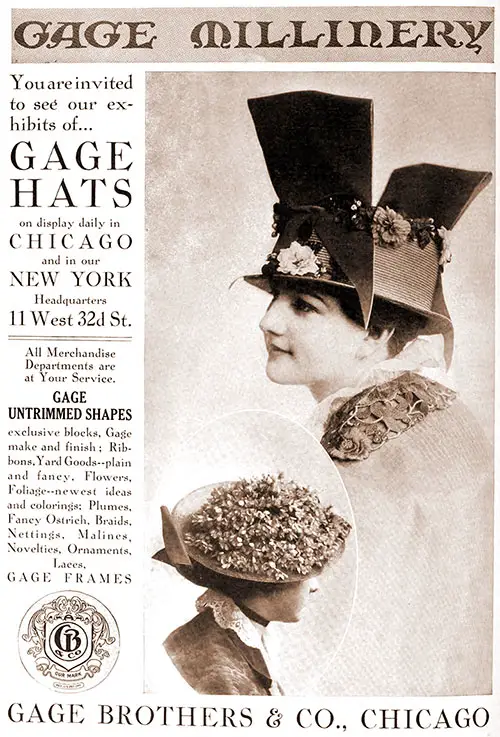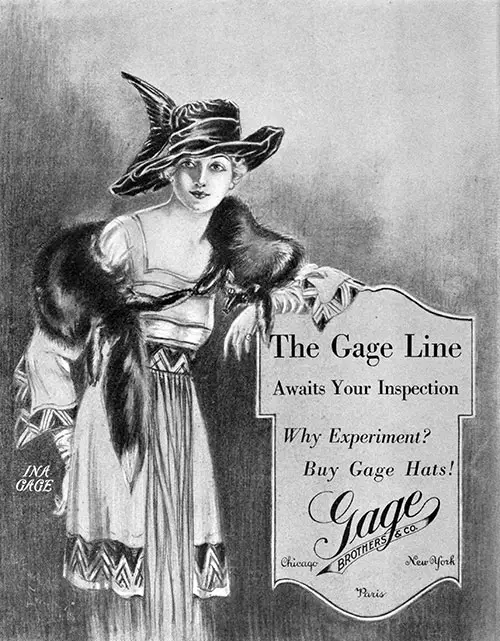Gage Brothers & Co
Gage Brothers & Co., have, since 1856, conducted continuously in Chicago a millinery business, which has grown until, at the present time (1913), in addition to our twelve-story building in Chicago, and our New York headquarters, we occupy two factories which manufacture "Gage" products exclusively.
Our designers and foreign buyers are in constant touch with the world's Fashion centers, with the result the Gage Hat is recognized by the trade as authoritative in style. We also manufacture Gage untrimmed shapes and popular priced hats for street and informal wear.
Gage Hats are Correct: Based on Exclusive and Authentic Importations from Paris. We have gone into the season's fashions fully in our Gage Newspaper, the latest issue of which is now off the press. Newest Hats, Untrimmed Shapes, and Merchandise are fully described and illustrated. Up to-the-minute news from foreign dispatches make this paper invaluable to the progressive dealer.

1914 Print Advertisement for Gage Brothers & Co., Chicago -- Exhibits of Gage Hats. The Illustrated Milliner, April 1914. GGA Image ID # 1661720d7b

One Price to All
Why has Gage Brothers & Co. adopted the plan of selling goods at strictly "One Price to All"? The reason for this action is self-evident. One price to all is a manifestly fair proposition. It is the right way, the fair way, and the only way.
The march of events has convinced every thinking mind that business, in order that it may have a lasting foundation, and enjoy confidence and mutual respect, must be based on equal opportunity to all. For this reason Gage Brothers & Co. have adopted the one price principle.
The original dealer was a trader, who exchanged his wares for those of the natives, who brought them to the trading post. There was consequently much variation in the value of the medium of exchange. After him came the jobber, who exchanged his goods for money only, and refused payment in commodities. Then arose the question of credits.
Manifestly there were some people to whom it was safer to sell goods on time than others, and if one were to take chances, he must have a compensating profit.
Gage Brothers & Co. faced this problem long ago, realizing that if it fixed a price on its merchandise which would warrant the credit risk, it would soon alienate its cash buyers. We decided to fix a price which would secure the trade of the responsible buyer.
The difference in the discount which the cash buyer receives and which the slow account loses is an item of profit which takes care of the difference in the risk. The customer who does not take advantage of the discount offered for prompt payment pays for the privilege of a longer time in the loss of the discount.
Under the principle of "One Price to All" the customer of Gage Brothers & Co. needs only to consider whether the item purchased is saleable at a profit over the purchase price, since it is obligatory upon us to establish a price which is absolutely the lowest to be obtained for equal value anywhere. The interests of our customers are co-ordinate with our own; their success means our success, and on this foundation, we build our business.
Another factor which is to be considered in the establishing of one price to all is the question of quantity. Undoubtedly a jobber can afford to sell a full piece of velvet, silk or lace on a smaller margin of profit than he can afford to sell an equal yardage which has been cut into several lengths.
There is the expense of cutting, wrapping, and handling, as well as the actual shrinkage due to faulty measuring; this same principle holds good in many other articles, including ribbons by the solid carton, flowers in the original boxes, and so on. We recognize this, and are prepared to make a quantity price which will compensate for the saving in expense and warrant the purchase of the additional amount.
Since this price is open to all on the same basis, it is consistent with our policy of "One Price to All."
Gage Brothers & Co. will mark a margin of profit on its merchandise which will enable us to sell dealers at a price which will be an inducement to all buyers. We are able to do this because we have at our disposal the output of our two factories, and because of foreign connections which place the markets of the world at our call.
By declining to sell to irresponsible merchants we have reduced our losses to an extremely small percentage, and in this way have made it possible to sell the responsible merchant on a proportionately smaller margin.
Gage Brothers & Co. in its effort to simplify and standardize the millinery business asks the co-operation of all merchants who appreciate fair dealings and correct business methods.
Our great assortment of merchandise gathered from all over the world is for sale on absolutely equal terms to responsible dealers everywhere.
"One Price to All," in The Illustrated Milliner: The American Authority on Millinery, New York: The Illustrated Milliner Co., Vol. XV, No. 8, August 1914, p. 93.

